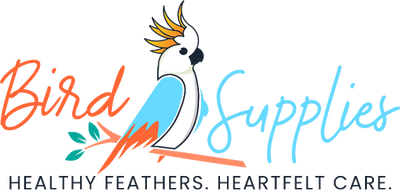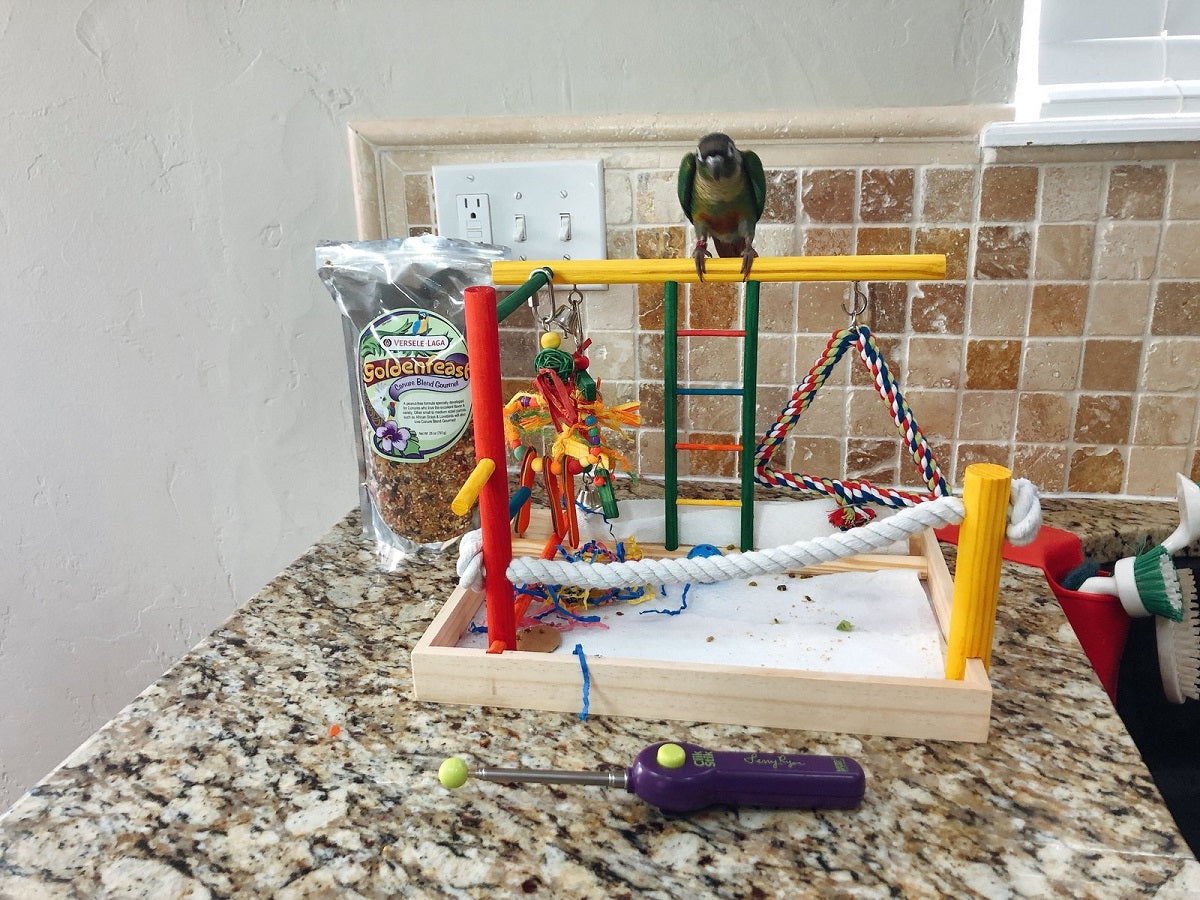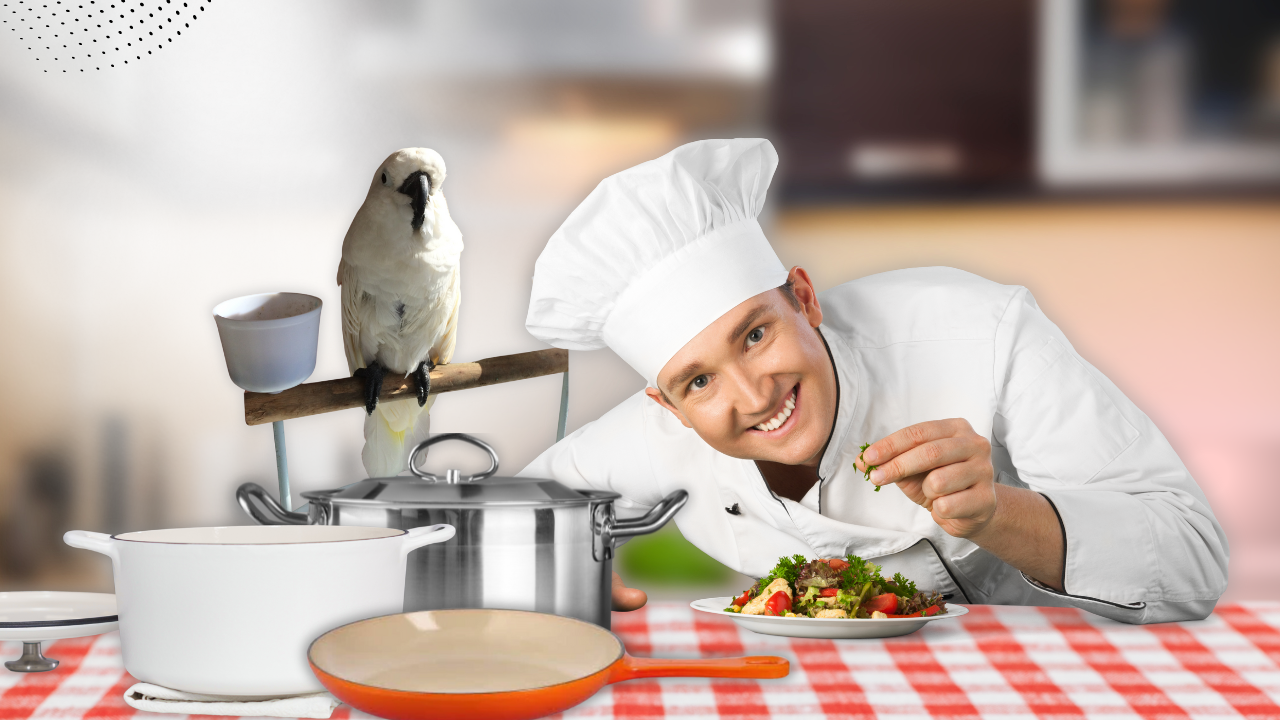Table of Contents
- What does a training clicker do?
- What is a bird clicker?
- How does clicker training work with parrots?
- How do you clicker train a parakeet?
- What age should you start clicker training?
- Clicker Training Supplies
- The 10 Steps to Follow: Clicker Training for Birds
- Step 1: Work On Your Timing
- Step 2: Find The Right Reward for Your Bird
- Step 3: Charge the Clicker (Form the Association)
- Step 4: Teach New Behaviors
- Step 5: Take a Break and Reward Yourself!
- Step 6: Raise the Stakes
- Step 7: Raise the Stakes, Again
- Step 8: Use a Cue
- Step 9: Start Getting Stingy With the Rewards
- Step 10: Try It Everywhere!
Did you know that Psychologist B.F. Skinner trained pigeons to perform complex behaviors using reinforcement methods?
What does a training clicker do?
Clicker training is one of the most effective ways to train your pet. First of all, it operates on science-backed positive reinforcement. (BirdSupplies.com - the home of Science-backed Parrot Wellness). Every time that your bird hears the unique click sound from the clicker, it gets excited because it knows it's going to be rewarded.
The click sound actually marks the exact behavior that you want to see more of in real time. The click communicates to your bird, “Good job! You're going to get a treat for that behavior in just a minute.”
Just imagine how much quicker bird training will progress when your bird looks forward to training sessions and you're communicating effectively with it.
What is a bird clicker?
A bird clicker it's a small handheld device that makes a distinctive clicking noise when you press the button. Most clickers are simply the clicking device, however you can buy them with a target stick attached to it. The target stick allows you to point to what you want your bird to touch. So now, instead of waiting for your bird to correctly guess what you want it to do you're able to show it instead, and on top of that when you click the clicker you've communicated to your bird, “hey you got it right!”
How does clicker training work with parrots?
Parrots are very intelligent and they learn quickly. As flock members, they want to fit in. When you train with a clicker and your bird understands what you want quickly and it feels like it fits in with your little flock! There is no room for negativity in clicker training.
Your job as the trainer is to notice the desired behavior, click as quickly as possible, and administer the reward. As the new Behavior becomes more ingrained you'll want to match it up with a “cue.” This could be a label or word for the behavior, like ” Step Up!” it could also be a hand gesture such as sticking your index finger out parallel to your bird by.
You'll find yourself enjoying the training sessions as much as your bird does because your mind is focused on what your bird is doing well and on progress rather than becoming frustrated when your bird can't figure out what you want it to do.
How do you clicker train a parakeet?
Whether your clicker training a parakeet or a macaw oh, the strategies are the same.
- Load the clicker so that the bird learns that when it hears the “click” sound, it's getting a reward.
- Decide on a simple behavior that you want to see more of and figure out the simplest approximations of that behavior.
- Now, try to elicit that simple approximation by watching carefully for your bird's attempts. Click and treat the simplest effort.
- Next, you'll want to shape closer and closer assimilations until the bird is actually performing the exact behavior that you want to see more of.
- Finally, you’ll add more steps to the behavior before clicking and treating as your bird shows proficiency.
So, getting back to stepping up, you might start off with your bird picking up one foot. Next, progress to your bird putting one foot on your finger. and, ultimately putting both feet on your finger which is the act of stepping up.
What age should you start clicker training?
You can start clicker training as soon as your bird is weaned. At this age your bird is feeling a little more independent and is ready to learn. Clicker training is so effective that you'll find yourself using it even as your bird gets older.
Anytime that you want your bird to repeat a behavior, find ways to reinforce the behavior. Clicker training maintains a healthy, positive relationship between you and your bird.
Clicker Training Supplies
- Bird Training Stand
- Clicker or a Target Stick
- Treats
- Treat Pouch or Dispensing Cup
The 10 Steps to Follow: Clicker Training for Birds
In this section of the article, we’ll go over the ten steps you need to follow to train your bird using a clicker!
It isn’t as complicated as you might think!
Step 1: Work On Your Timing
First of all, you need to prepare yourself to use the clicker. You need to work on your timing because timing is crucial when it comes to clicker training.
First, you’ll need to perfect when you click. Imagine that you’re trying to teach your bird to wave hello and you click when your bird is putting its foot down. Your bird is going to think that the behavior that it's being rewarded for is putting its foot down.
You’ll also want to deliver the treat reward in a timely manner, especially in the early phases of training. Start off by delivering the treat within one or two seconds and then increase the treat wait time slowly once the bird
You can practice clicker timing by playing a simple game! Watch your favorite TV show and press the clicker whenever someone says the word “Yes.” Make sure you press the clicker at the precise moment someone says yes.
Step 2: Find The Right Reward for Your Bird
Now, you need to figure out the right reward for your bird. Most birds are motivated by food, however, some birds are motivated by toys or affection and praise. You need to choose what works best for your feathered friend.
I recommend buying a premium parrot treat mix like Goldenfeast blends. These blends contain numerous dried fruits, grains, and nuts that parrots love. Grab a stainless steel measuring cup and fill it with several treats. Then, show your bird the filled cup and allow it to choose a treat. Usually, the bird will pick one of its favorite treats. Try this several times and choose about 3 treats that your pet really goes for.
Step 3: Charge the Clicker (Form the Association)
You’ve got to teach your bird what the clicker is. We call this “charging the clicker.” Here’s how to do it.
- Grab a cup of your bird's favorite treats, a T-style bird stand, and your clicker.
- Remember that you’re not training for behavior just yet. Click the clicker and immediately offer your bird the treat cup.
- Take a little break, as if the training session is about to end.
- When your bird gets distracted and stops paying attention to the clicker, click again. This time work on having your bird look at you before you treat. Once your bird routinely looks at you to get the treat, you’ll know that your bird is making the association that the clicker is a signal that you’ll deliver a treat.
- Practice charging the clicker twice a day for about a week. Keep the training sessions short, say, under a minute.
And, that’s how you associate the clicker with a positive reward!
Step 4: Teach New Behaviors
Now that your bird knows that a reward follows the clicker's sound, you need to get down to business!
You can train your bird tricks or you can train your bird for new manners. If you're not sure where to start, get the Clicker Training For Birds Book. It describes exactly how to train some pretty awesome bird manners for a life long companion.
Any training is a step in a positive direction in that your bird receives socialization, intellectual stimulation, and it is learning new replacement behaviors for problem behaviors.
Fun tricks include basketball, putting coins in a bank, waving, making sounds or words, puzzles, and more.
Essential bird manners include:
- Stepping up & Stepping Down
- Staying Put
- Coming When Called
- Potty Training
- How To Forage
- Willingly Enter Cage or Carrier
It’s time to start shaping behavior. Shaping is a force-free method of training in which you wait for your bird to perform a behavior and then click and treat. Force-free training uses humane methods to teach positive, new behaviors.
Rather than forcing a behavior, or intimidating and punishing the bird when it doesn’t perform as expected, you literally wait and watch to “catch your bird being good.” Then, make a big deal out of it.
Imagine what that does for the relationship! Your bird learns to trust you and actually desires to please you.
Let’s take an example. Say that you want to teach your bird to stay in an assigned area, an important skill to develop. It could be a new cage, a play stand, etc. When your bird knows how to stay put, it is much safer.
I just got a new baby Green Cheek Conure and I’ve got pet dogs, so this is right up my alley.
My dogs have been trained to “leave it,” but a fluttering tiny bird still seems like a toy, so Kiwi really needs to know how to stay put.
I could force her to stay put by grabbing her up and placing her back on her play stand every time she gets off. That just turns into a battle of the wills which never turns out well.
Instead, I decided to motivate her to want to stay on her play stand.
I’ve had Kiwi long enough that I know what motivates her.
- Food: Kiwi loves her veggies! She enjoys many of the ingredients in Goldenfeast Conure Blend. That’s not her regular food. She eats seeds, veggies, & Roudybush California Blend. I’ve chosen a few small grains from and some favorite veggies to train her to stay put.
- Bathing In A Dish: This little girl loves to splash around in a shallow dish of water
- Toys: Like most small birds, Kiwi loves chewing on natural, plant-based toys.
- Freedom: Kiwi wants to be out and about with the fam. Rather than being confined to a cage, she enjoys being in the living area and a part of the action.
So, here is how I “force-free” trained Kiwi to stay put. I started out on what we call a “fixed schedule.” This is where we temporarily schedule to reward the behavior that we want to see more of a lot.
- I made her play stand a fun place to be by stocking it with toys, food, and water.
- I set the stage by placing the stand on a portion of the counter that has nothing on it that she might want to explore.
- Then, every time that I observed Kiwi playing, perching nicely, and foraging, I’d immediately click and treat the behavior.
- If she got off of the play stand, the set up was that it was just plain boring and she’d eventually get back on the stand. Then, I made it a point to observe her so that when she got back on the stand, I’d click and treat.
Step 5: Take a Break and Reward Yourself!
Clicker training sounds simple and easy, but it is a lot of work. First, you’ve got to plan your strategy, then you’ve got to commit to observing for the behavior that you want to reward, and do it consistently.
You’re doing a good job! Take frequent breaks between training sessions and reward yourself with your favorite TV show or a cup of coffee.
Step 6: Raise the Stakes
In this step, we’re making it harder for your bird to get rewarded. This is where you’re more precisely shaping the behavior that you want to see more of. So, once the desired behavior is established, we change our schedule of reinforcement to be more random in nature.
So, you don’t immediately reward your bird for taking a step in the right direction. You wait until the bird has performed the desired behavior twice, and then increase it to four times before treating, then six before clicking and treating.
You intermittently reward the behavior, so that when the bird does get a reward its like a big surprise
And, you reward it only if it goes to the right spot.
It’s kind of like hitting the jackpot! And, it’s an incredibly motivating strategy.
Step 7: Raise the Stakes, Again
Once your bird knows that it’ll be rewarded if it is at a particular spot, change the starting point! Move further away from the bird’s assigned are and reward your bird if stays in the assigned spot.
Soon, your bird will independently monitor itself to stay in its assigned spot.
Step 8: Use a Cue
It’s time to name the behavior!
You can use a word or a phrase. Here, we’ll use the phrase, “spot” or “stay”
- Bring your bird to the starting point and use the cue. If your bird goes to the spot, reward it.
- Repeat until your bird goes the spot every time you use the cue.
- Don’t reward your bird if she goes the spot without the cue, but still reward her every time you use it.
Now your bird knows to go to its spot on cue!
Step 9: Start Getting Stingy With the Rewards
It isn’t going to be practical to reward your bird every time you use the cue.
So, what do you do?
You use a variable reinforcement schedule. This keeps your bird motivated to go to the spot every time you use the cue without you having to give out a reward all the time. We recommend using a variable ratio schedule.
You reward your bird after a certain average number of responses. So, you reward your bird every 4-6th time it has gone to the assigned spot after hearing the cue.
Why a variable ratio schedule?
It is the hardest to extinct. Your bird will not un-learn the behavior learned easily. If you don’t use a variable reinforcement schedule, then the minute you stop treating your bird for performing the desired behavior, the just gives up trying.
Step 10: Try It Everywhere!
Make sure your bird knows to follow the cue under all circumstances! Try it when you have people over or when the television is playing on the background, etc. Make sure your feathered friend repeats the behavior at all times.
And that’s all you need to know! Wasn’t too difficult, right? Conclusion: Clicker Training for Birds
Did we help you out?
In Conclusion
Clicker training uses the concept of Operant or Instrumental conditioning. So, the reward you present to your bird increases its likelihood of performing the behavior rewarded.
Clicker training can be used with other animals like dogs, cats, rabbits, etc.
If you have any questions or concerns, leave them in the comments, and we’ll get back to you as soon as we can.
Related Posts:
Choosing Parrot Training Supplies
Diane Burroughs, LCSW is a licensed psychotherapist trained in ABA therapy techniques. She specializes in avian anxiety disorders and is certified in Nutrition For Mental Health. Diane has written a number of bird behavior books and she offers behavior consultations. She's developed a range of UnRuffledRx Science-backed Parrot Wellness Supplies.
Diane's products have been featured in the Journal of Avian Medicine and Surgery and at Exoticscon, a conference for exotic pet veterinarians. Her bird collars & supplements are stocked in avian vet clinics and bird stores throughout the US. With over 30 years in the field of behavior, Diane has created thousands of successful individualized behavior plans that help pets thrive.
TAGS: #ClickerTrainingForBirds #BirdClickerTraining #BirdTraining
SHARING IS CARING! PLEASE SHARE ON YOUR FAVORITE SOCIAL MEDIA NOW!





